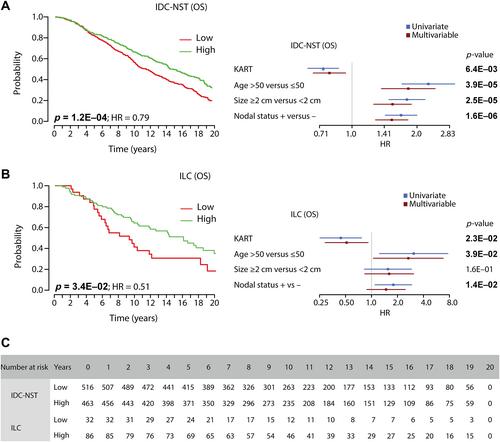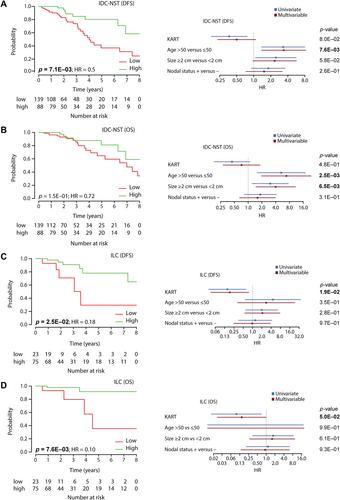Canonical Kaiso target genes define a functional signature that associates with breast cancer survival and the invasive lobular carcinoma histological type
Thijmen Sijnesael, François Richard, Max AK Rätze, Thijs Koorman, Blessing Bassey-Archibong, Christa Rohof, Juliet Daniel, Christine Desmedt, Patrick WB Derksen
下载PDF
{"title":"Canonical Kaiso target genes define a functional signature that associates with breast cancer survival and the invasive lobular carcinoma histological type","authors":"Thijmen Sijnesael, François Richard, Max AK Rätze, Thijs Koorman, Blessing Bassey-Archibong, Christa Rohof, Juliet Daniel, Christine Desmedt, Patrick WB Derksen","doi":"10.1002/path.6205","DOIUrl":null,"url":null,"abstract":"<p>Invasive lobular carcinoma (ILC) is a low- to intermediate-grade histological breast cancer type caused by mutational inactivation of E-cadherin function, resulting in the acquisition of anchorage independence (anoikis resistance). Most ILC cases express estrogen receptors, but options are limited in relapsed endocrine-refractory disease as ILC tends to be less responsive to standard chemotherapy. Moreover, ILC can relapse after >15 years, an event that currently cannot be predicted. E-cadherin inactivation leads to p120-catenin-dependent relief of the transcriptional repressor Kaiso (ZBTB33) and activation of canonical Kaiso target genes. Here, we examined whether an anchorage-independent and ILC-specific transcriptional program correlated with clinical parameters in breast cancer. Based on the presence of a canonical Kaiso-binding consensus sequence (cKBS) in the promoters of genes that are upregulated under anchorage-independent conditions, we defined an ILC-specific anoikis resistance transcriptome (ART). Converting the ART genes into human orthologs and adding published Kaiso target genes resulted in the Kaiso-specific ART (KART) 33-gene signature, used subsequently to study correlations with histological and clinical variables in primary breast cancer. Using publicly available data for ER<sup>POS</sup>Her2<sup>NEG</sup> breast cancer, we found that expression of KART was positively associated with the histological ILC breast cancer type (<i>p</i> < 2.7E-07). KART expression associated with younger patients in all invasive breast cancers and smaller tumors in invasive ductal carcinoma of no special type (IDC-NST) (<2 cm, <i>p</i> < 6.3E-10). We observed associations with favorable long-term prognosis in both ILC (hazard ratio [HR] = 0.51, 95% CI = 0.29–0.91, <i>p</i> < 3.4E-02) and IDC-NST (HR = 0.79, 95% CI = 0.66–0.93, <i>p</i> < 1.2E-04). Our analysis thus defines a new mRNA expression signature for human breast cancer based on canonical Kaiso target genes that are upregulated in E-cadherin deficient ILC. The KART signature may enable a deeper understanding of ILC biology and etiology. © 2023 The Authors. <i>The Journal of Pathology</i> published by John Wiley & Sons Ltd on behalf of The Pathological Society of Great Britain and Ireland.</p>","PeriodicalId":232,"journal":{"name":"The Journal of Pathology","volume":"261 4","pages":"477-489"},"PeriodicalIF":5.6000,"publicationDate":"2023-09-22","publicationTypes":"Journal Article","fieldsOfStudy":null,"isOpenAccess":false,"openAccessPdf":"https://pathsocjournals.onlinelibrary.wiley.com/doi/epdf/10.1002/path.6205","citationCount":"0","resultStr":null,"platform":"Semanticscholar","paperid":null,"PeriodicalName":"The Journal of Pathology","FirstCategoryId":"3","ListUrlMain":"https://onlinelibrary.wiley.com/doi/10.1002/path.6205","RegionNum":2,"RegionCategory":"医学","ArticlePicture":[],"TitleCN":null,"AbstractTextCN":null,"PMCID":null,"EPubDate":"","PubModel":"","JCR":"Q1","JCRName":"ONCOLOGY","Score":null,"Total":0}
引用次数: 0
引用
批量引用
Abstract
Invasive lobular carcinoma (ILC) is a low- to intermediate-grade histological breast cancer type caused by mutational inactivation of E-cadherin function, resulting in the acquisition of anchorage independence (anoikis resistance). Most ILC cases express estrogen receptors, but options are limited in relapsed endocrine-refractory disease as ILC tends to be less responsive to standard chemotherapy. Moreover, ILC can relapse after >15 years, an event that currently cannot be predicted. E-cadherin inactivation leads to p120-catenin-dependent relief of the transcriptional repressor Kaiso (ZBTB33) and activation of canonical Kaiso target genes. Here, we examined whether an anchorage-independent and ILC-specific transcriptional program correlated with clinical parameters in breast cancer. Based on the presence of a canonical Kaiso-binding consensus sequence (cKBS) in the promoters of genes that are upregulated under anchorage-independent conditions, we defined an ILC-specific anoikis resistance transcriptome (ART). Converting the ART genes into human orthologs and adding published Kaiso target genes resulted in the Kaiso-specific ART (KART) 33-gene signature, used subsequently to study correlations with histological and clinical variables in primary breast cancer. Using publicly available data for ERPOS Her2NEG breast cancer, we found that expression of KART was positively associated with the histological ILC breast cancer type (p < 2.7E-07). KART expression associated with younger patients in all invasive breast cancers and smaller tumors in invasive ductal carcinoma of no special type (IDC-NST) (<2 cm, p < 6.3E-10). We observed associations with favorable long-term prognosis in both ILC (hazard ratio [HR] = 0.51, 95% CI = 0.29–0.91, p < 3.4E-02) and IDC-NST (HR = 0.79, 95% CI = 0.66–0.93, p < 1.2E-04). Our analysis thus defines a new mRNA expression signature for human breast cancer based on canonical Kaiso target genes that are upregulated in E-cadherin deficient ILC. The KART signature may enable a deeper understanding of ILC biology and etiology. © 2023 The Authors. The Journal of Pathology published by John Wiley & Sons Ltd on behalf of The Pathological Society of Great Britain and Ireland.
典型Kaiso靶基因定义了与乳腺癌生存和浸润性小叶癌组织学类型相关的功能特征
侵袭性小叶癌(Invasive lobular carcinoma, ILC)是由E-cadherin功能突变失活导致锚定独立性(anoikis resistance)获得的一种低至中度组织学乳腺癌类型。大多数ILC病例表达雌激素受体,但在复发的内分泌难治性疾病中,选择有限,因为ILC往往对标准化疗反应较差。此外,ILC可能在15年后复发,这是目前无法预测的事件。e -钙粘蛋白失活导致p120-连环蛋白依赖性转录抑制因子Kaiso (ZBTB33)的缓解和典型Kaiso靶基因的激活。在这里,我们研究了不依赖于锚定和ilc特异性的转录程序是否与乳腺癌的临床参数相关。基于在锚定不依赖条件下上调的基因启动子中存在典型的kaiso结合共识序列(cKBS),我们定义了ilc特异性anoikis抗性转录组(ART)。将ART基因转化为人类同源基因,并添加已发表的Kaiso靶基因,产生Kaiso特异性ART (KART) 33基因标记,随后用于研究原发性乳腺癌与组织学和临床变量的相关性。利用ERPOSHer2NEG乳腺癌的公开数据,我们发现KART的表达与组织学上的ILC乳腺癌类型呈正相关(p < 2.7E-07)。KART表达与所有浸润性乳腺癌中年轻患者和无特殊类型浸润性导管癌中较小肿瘤相关(IDC-NST) (<2 cm, p < 6.3E-10)。我们观察到ILC(风险比[HR] = 0.51, 95% CI = 0.29-0.91, p < 3.4E-02)和IDC-NST(风险比[HR] = 0.79, 95% CI = 0.66-0.93, p < 1.2E-04)与良好的长期预后相关。因此,我们的分析基于在E-cadherin缺乏ILC中上调的标准Kaiso靶基因,定义了人类乳腺癌新的mRNA表达特征。KART标记可以使人们更深入地了解ILC的生物学和病因。©2023作者。《病理学杂志》由约翰·威利出版;儿子有限公司代表大不列颠及爱尔兰病理学会。
本文章由计算机程序翻译,如有差异,请以英文原文为准。




